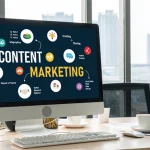Have you ever been curious as to why some companies see incredible conversion rates from their online advertising while others fail even after putting in an equal investment? The high-speed digital marketing environment creates constant pressure to convert clicks into substantial actions, and the key often lies not in the ads themselves but in where those ads go.
In this blog article, we’ll go deeper into the world of PPC landing pages, discover why they matter, and look at strategies to optimise them to generate maximum output. We will learn about PPC landing page templates in general usage as well as highlight some tips so that you will be able to produce high-performing landing pages.
What Are PPC Landing Pages?
In simpler terms, a PPC landing page is a unique, standalone webpage that a visitor is taken to after clicking on an ad. While general website pages offer a range of information and are designed to perform a variety of tasks, a PPC landing page is laser-focused. The purpose of this page is to deliver precisely what the visitor anticipates upon clicking your advertisement, bringing them to the next step, be it making a purchase, registering for a service, or providing their contact information.
Importance Of PPC Campaigns
Why is a PPC landing page so crucial to the big picture of your campaign? When you are paying for clicks, you want your clicks to convert. Without an optimised landing page, even the best PPC ads can yield disappointing outcomes. Your PPC landing page will directly affect your quality score on sites such as Google Ads, which in turn affects your ad placement and cost-per-click (CPC).
A well-optimised and highly relevant landing page can assist in bringing out your ad relevance, increasing conversion rates, and eventually reducing your cost-per-click. It could be considered the last piece of the puzzle in making your PPC campaign generate the best possible return on investment (ROI).
Role Of PPC Landing Pages In Digital Marketing
Enhancing ad relevance and quality score
Search engines such as Google analyse the relevance between your landing pages and your ads. If they match very well, then your quality score increases, causing your ad position to improve as well as the cost per click to decrease. A properly built PPC landing page that follows the conversation initiated by your ad lets search engines know that you are offering value to users.
Improving conversion rates
As opposed to your homepage, which can have various uses, a PPC landing page has one overriding purpose. Without any distractions, the page then outlines a definitive route to the objective, increasing the rate at which visitors become clients. Here at ODigMa, our clients typically see higher conversion rates (3-5 times) on dedicated PPC landing pages when compared to directing traffic to general website pages.
Reducing cost-per-click (CPC)
What is the role of a landing page in a PPC campaign when it comes to cost efficiency? It’s pretty substantial. Better landing page experiences equate to better quality scores, which in turn can cut down your cost-per-click. This cost-effectiveness lets you get more mileage out of your advertising budget while deriving better results.
Key Elements of an Effective PPC Landing Page
Compelling Headlines and Subheadings
Your headline is perhaps the most critical component of your landing page. Remember to incorporate content that can achieve multiple things at once, such as:
- Convince visitors that they’ve come to the correct location after clicking on the ad
- Sustain consistency with your ad copy’s messaging
- Communicate your main value proposition clearly
Clear and Persuasive Call-to-Action (CTA)
All PPC landing pages should have an undeniable call to action that informs the visitor precisely what to do next. Your CTA should:
- Contrast visually with the rest of the page
- Be action-oriented and create a sense of urgency
- Clearly state the value gained by the visitor
Relevant and Engaging Visuals
The human brain reads images quicker than text, and images are an extremely effective means of conveying your value proposition. Successful PPC landing pages incorporate:
- Quality product images and screenshots that include live testimonials to build an emotional bond
- Diagrams or infographics that explain the value proposition
- Short video demonstrations to boost engagement
Trust Signals
Visitors landing on your PPC page from an advertisement usually do not know your brand well. Hence, to build credibility and create a warm, inviting tone, include signs of trust that counteract the initial distrust. Some of them include:
- Testimonials from customers with their full names and photos
- Case studies with quantifiable, measurable outcomes
- Partnerships and industry certifications
- Security badges on pages that require sensitive data
- Social proof signals like client logos or user numbers
Optimised Forms for Lead Capture
If lead generation is your goal for the landing page, then design your form by embedding relevant data and questions, put together invitingly. Try:
- Asking for information that you only strictly need at this point
- Splitting longer forms into steps to limit perceived complexity
- Employing inline validation to offer instant feedback
- Sizing and labelling form fields correctly
Best Practices For Creating High-Converting PPC Landing Pages
Aligning landing page content with ad copy
“Message match” simply means the matching copy present on your landing page and in your ad. The match should have visual similarity in colour, image, and overall appearance. Headlines should be consistent, using the same words and value proposition, and should fill out the specifics offered in the advertisement. When customers are provided with such continuity, they feel confident about the smart decision they have made by clicking your ad, decreasing bounce rates and building engagement.
Ensuring fast page load speed and mobile responsiveness
“Performance optimization” translates to your landing page loading in an optimal amount of time and operating efficiently on any device. Such an initiative places focus on speed as a criterion: less than 3-second page loads, compressed images, and targeted content processing. The pages need to be perfectly responsive with touch-oriented UI components that function across any screen resolution.
Simplifying design and minimising distractions
Conversion-driven design means you have to curate each element present in your PPC landing page to work towards your top goal. This design eliminates typical navigation headers that might interrupt visitors, dispenses with links that aren’t necessary, and uses white space strategically to prioritise content. Your visual hierarchy should direct attention organically towards critical messaging and call-to-action points.
Utilising A/B testing for continuous improvement
This initiative requires you to test single variables in isolation to be able to distinctly see performance drivers, giving precedence to tests that influence headlines and CTAs for the greatest impact, and only applying changes after sustaining statistical significance. Recording all test results creates useful organisational knowledge, with segmentation analysis giving insight into the varying responses from different audience segments.
Common Mistakes to Avoid in PPC Landing Pages
Mismatched Messaging Between Ads and Landing Pages
If your advertisement and landing page don’t convey the same point clearly, consumers don’t see what was promised, and they bounce right away. This inconsistency wastes ad spend and destroys user trust.
Overwhelming Visitors with Information or Choices
Too many choices or too much information will paralyse decision-making. Simple and direct communication helps convey one simple, undeniable value proposition and triggers the next step.
Poorly Designed Forms and Unclear CTAs
With poorly designed forms and unclear CTAs, users do not have clarity on the topic they are venturing into, and when users can’t quickly decide what to do next or encounter friction in your conversion flow, they are more likely to abandon the page.
Ignoring Analytics Data and User Behaviour Insights
The best PPC landing pages are dynamic, and leverage analytic data and actual user behaviour to generate insights. Employ heatmaps, session recordings, and conversion metrics on a regular basis to discover areas for optimisation.
Tools for Building and Optimising PPC Landing Pages
With the rate of advancements we see today, there are various platforms you can use to create and optimize PPC landing page templates. Some of these platforms are:
Unbounce
Unbounce offers drag-and-drop editors with various templates that have been optimised specifically for PPC campaigns.
Instapage
Instapage is another platform commended for its integration features and advanced A/B tests to see how your ad is performing and to understand whether it needs to be optimised further.
Leadpages
Leadpages is a platform that offers fairly affordable options for high-performing templates created based on changing conversion rates.
HubSpot Landing Page Builder
Having native compatibility with HubSpot’s CRM, the HubSpot landing page builder allows for better lead tracking and nurturing using purpose-built metrics.
At ODigMa, we help clients choose the right tools based on their specific needs and technical ability, typically deploying data-driven solutions to enhance the existing marketing technology stacks. Visit our website or reach out to us to see how your social presence can be taken to new heights with ODigMa.
Measuring The Success Of Your PPC Landing Page
In order to truly understand the effectiveness of your ad spends and campaigns, you need data. Listed below are some of the key metrics you should track, along with tools you can use to derive insights from this data.
Key Metrics to Track
- Conversion rate: Percentage of visitors who take your desired action
- Bounce rate: Percentage of visitors who bounce away without having interacted at all
- Time on page: The amount of time visitors spend looking at your content
- Form abandonment rate: Number of users who begin but don’t complete your form
Performance Analysis Tools
Google Analytics provides bottom-line data, while tools like Hotjar or Crazy Egg offer visual data in the form of heatmaps and session recordings, which reveal exactly how users interact on your page.
Future Trends in PPC Landing Page Optimisation
Personalisation with AI-Driven Insights
Machine learning is revolutionising landing page optimisation with:
- Dynamic content that adjusts according to visitor profiles
- Predictive analytics that identify the most likely conversion sequences for different segments
- Automated testing that continuously optimises without any human intervention
- Intent-based personalisation that matches content with search intent
- Behavioural targeting that adapts based on behaviour and patterns
Interactive Elements and Dynamic Content
- Calculators that provide real-time estimates or ROI projections
- Evaluation tools that provide visitors with tailored recommendations
- Interactive demonstrations that engage visitors in an active manner
- Chatbots that provide contextual, real-time assistance
In Closing
A well-designed PPC landing page is the ideal extension of the promise made in your advertisement. You can turn ad clicks from traffic data into worthwhile business consequences by developing targeted, pertinent PPC landing pages that preserve message coherence, remove distractions, and direct visitors towards obvious actions.
Our team of digital marketing experts at ODigMa has assisted brands from a variety of sectors in creating and refining landing pages that yield the necessary outcomes. Whether you’re new to PPC advertising or are trying to make your current campaigns better, our data-driven strategy makes sure your landing pages are as effective as your ads. Visit our website to find out more about how your online marketing effectiveness can be improved with our all-inclusive digital consulting services.
Frequently Asked Questions
1. What is a PPC landing page?
A PPC landing page is a dedicated webpage designed specifically to receive traffic from pay-per-click advertising campaigns, with the goal of converting visitors into leads or customers through a focused experience that eliminates distractions and emphasises a single conversion action.
2. How do PPC landing pages differ from regular website pages?
Unlike regular website pages that often serve multiple purposes and audiences, PPC landing pages are laser-focused on a single conversion goal, remove navigation options that could distract visitors, maintain strict message continuity with the ads that lead to them, and are specifically designed and optimised for conversion rather than general information or brand awareness.
3. How can I improve my PPC landing page quality score?
To improve your quality score, employ strong message matches between your ads and landing page content, improve page load speed (particularly on mobile devices), make your page fully responsive across all screen sizes, include relevant keywords naturally in your copy without keyword stuffing, add meaningful content that addresses visitor questions and objections, and regularly update content based on performance data and industry developments.
4. What are the common reasons for low conversion rates on PPC landing pages?
Common causes include misalignment between ad promises and landing page content, slow load times that frustrate visitors, complicated forms requesting excessive information, unclear value propositions that fail to communicate benefits, lack of trust signals that create hesitation, poor mobile experiences, weak or confusing calls-to-action, and information overload that creates decision paralysis.
5. Are there free tools available to create PPC landing pages?
Yes, platforms like Google Sites, WordPress with landing page plugins such as Elementor or Beaver Builder, and some email marketing tools like MailChimp offer free or low-cost options for creating basic landing pages. However, for professional results with advanced testing capabilities, conversion optimisation features, and integration options, paid solutions typically provide significantly more value and a higher return on investment.


 Digital Marketing For Doctors In India
Digital Marketing For Doctors In India A Comprehensive Guide to Programmatic Advertising (2025)
A Comprehensive Guide to Programmatic Advertising (2025) How to choose the Best Search Engine Marketing (SEM) agency in Bangalore
How to choose the Best Search Engine Marketing (SEM) agency in Bangalore Social Media Marketing for Healthcare: The 5 Step Plan
Social Media Marketing for Healthcare: The 5 Step Plan Content Marketing for Startups: Building Brand & Driving Growth on a Budget
Content Marketing for Startups: Building Brand & Driving Growth on a Budget